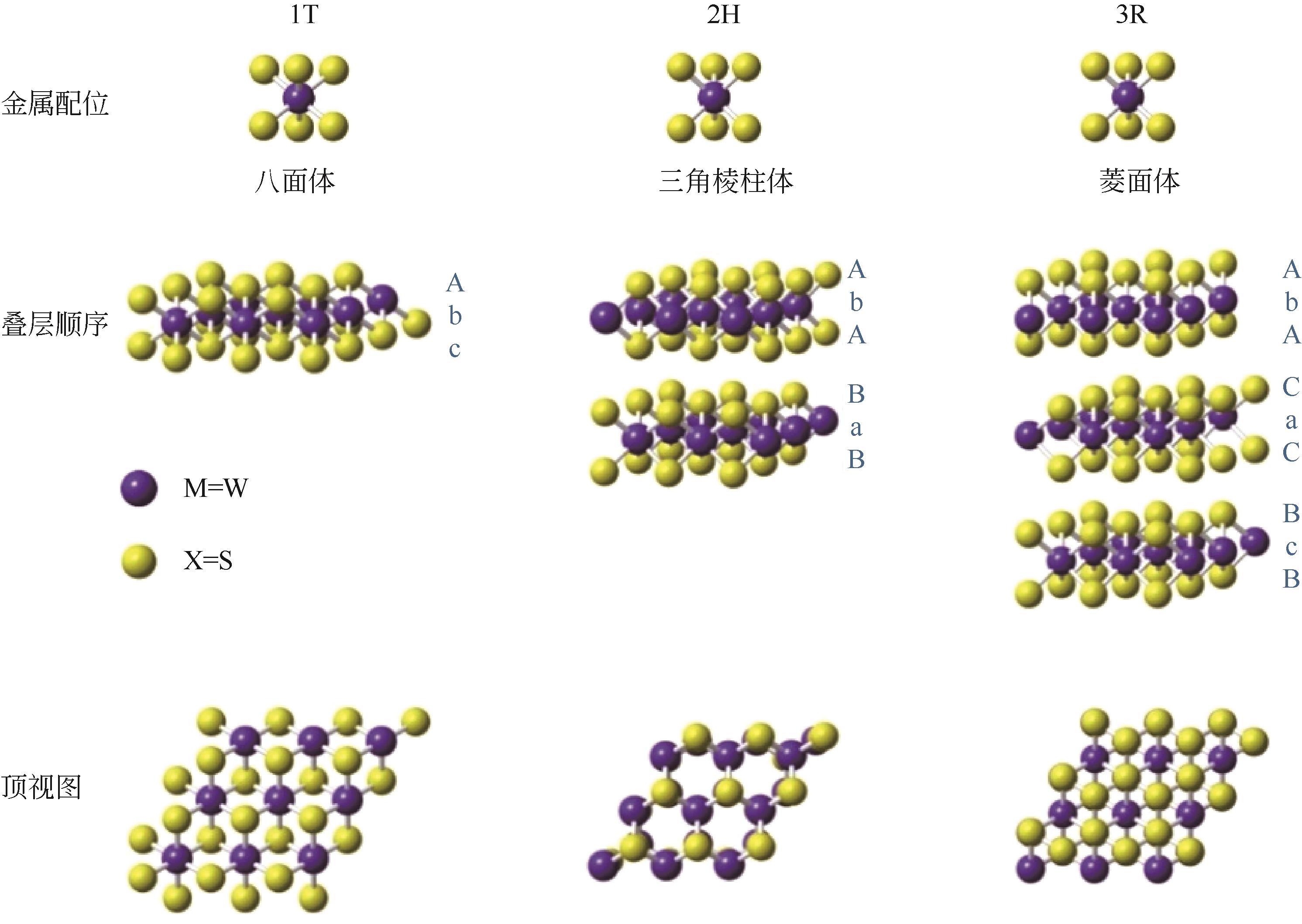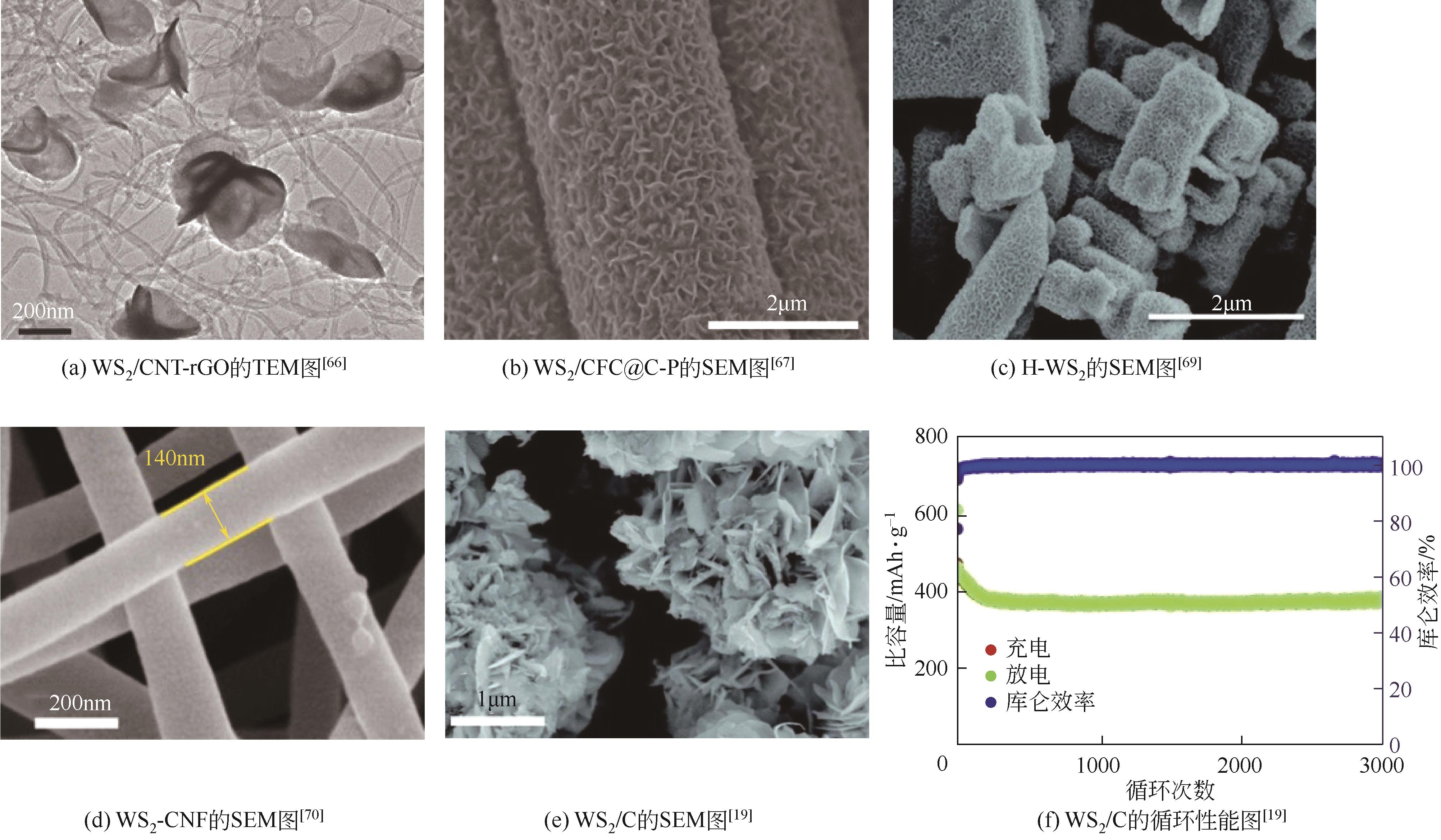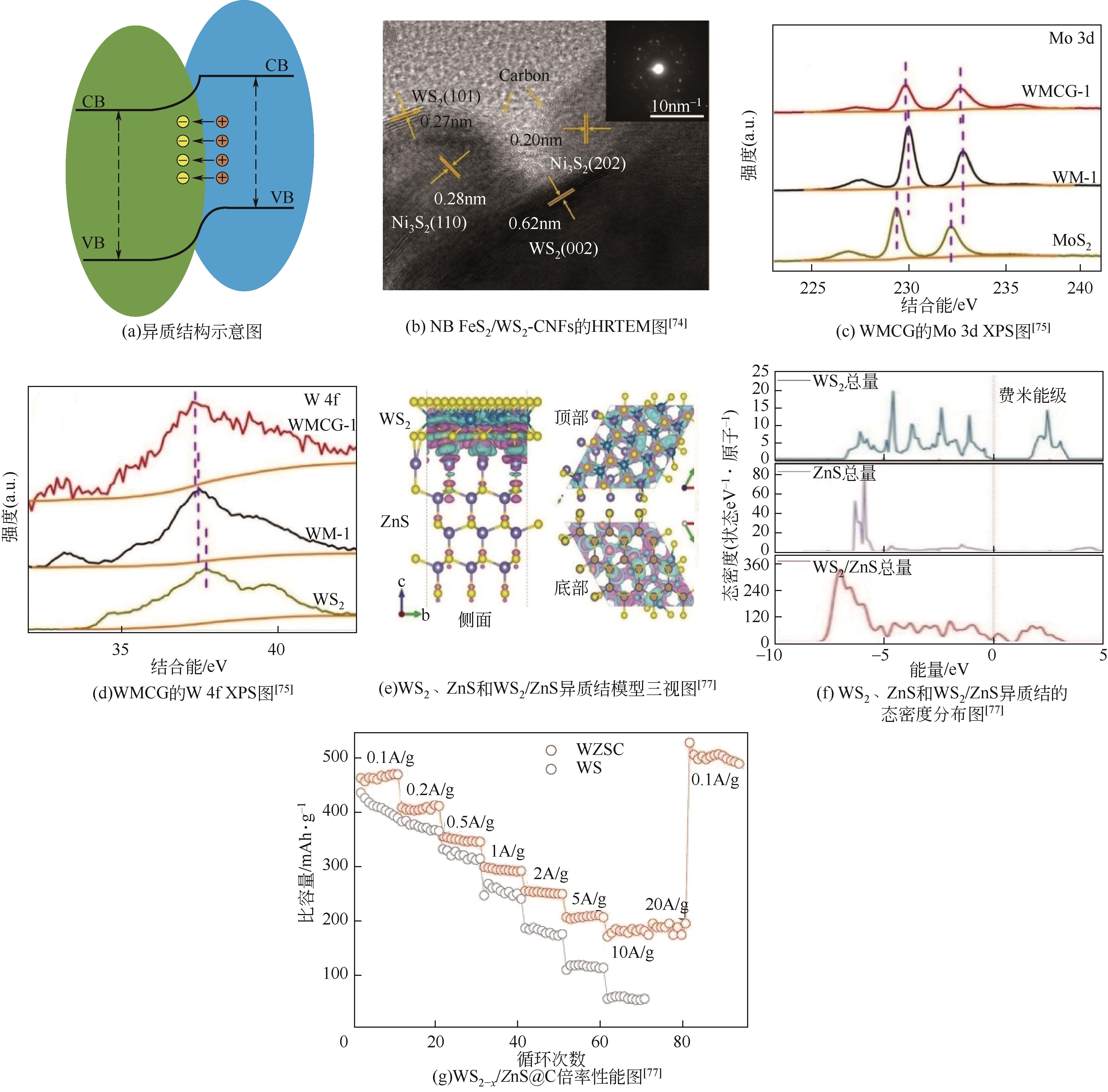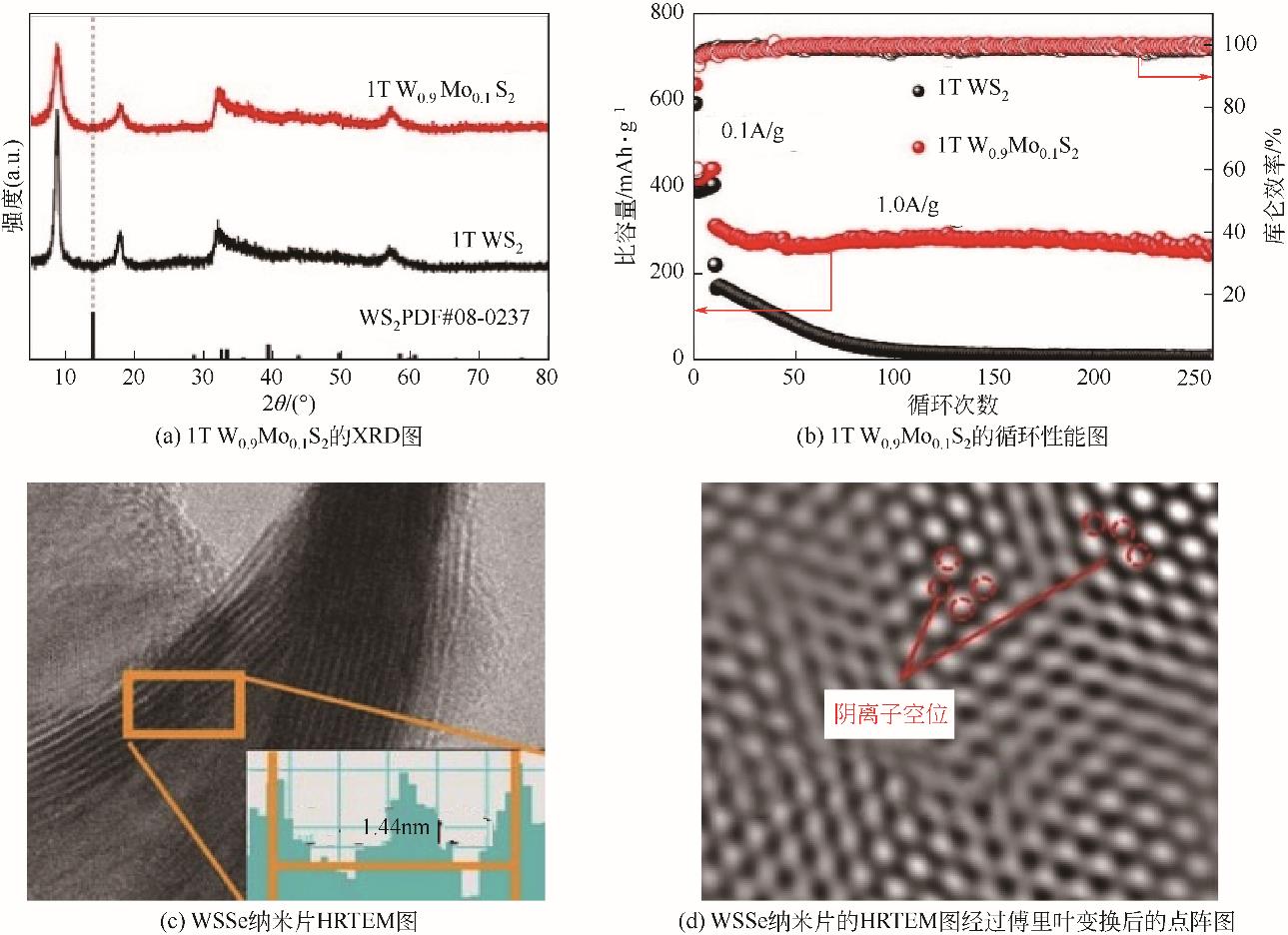化工进展 ›› 2023, Vol. 42 ›› Issue (S1): 344-355.DOI: 10.16085/j.issn.1000-6613.2023-0683
二硫化钨复合材料制备与储钠性能研究进展
胡喜( ), 王明珊(
), 王明珊( ), 李恩智, 黄思鸣, 陈俊臣, 郭秉淑, 于博, 马志远, 李星
), 李恩智, 黄思鸣, 陈俊臣, 郭秉淑, 于博, 马志远, 李星
- 西南石油大学新能源与材料学院,四川 成都 610500
-
收稿日期:2023-04-25修回日期:2023-07-07出版日期:2023-10-25发布日期:2023-11-30 -
通讯作者:王明珊 -
作者简介:胡喜(1998—),男,硕士研究生,研究方向为钠离子电池。E-mail:huxi20221119@163.com。 -
基金资助:国家自然科学基金面上项目(52072322);四川省科技计划项目重点研发项目(2022YFG0294)
Research progress on preparation and sodium storage properties of tungsten disulfide composites
HU Xi( ), WANG Mingshan(
), WANG Mingshan( ), LI Enzhi, HUANG Siming, CHEN Junchen, GUO Bingshu, YU Bo, MA Zhiyuan, LI Xing
), LI Enzhi, HUANG Siming, CHEN Junchen, GUO Bingshu, YU Bo, MA Zhiyuan, LI Xing
- School of New Energy and Materials, Southwest Petroleum University, Chengdu 610500, Sichuan, China
-
Received:2023-04-25Revised:2023-07-07Online:2023-10-25Published:2023-11-30 -
Contact:WANG Mingshan
摘要:
二硫化钨(WS2)作为一种典型的二维过渡金属硫化物具有宽阔的层间距(6.2Å,1Å=0.1nm)和多电子转化反应储钠机制,是一种具有高理论比容量和快速钠离子反应动力的钠离子电池负极材料。但其在实际储钠过程中,2H相结构的WS2固有的电子导电性较差,转化反应带来较大的相结构转变和体积变化,以及充放电过程中还原中间产物多硫化钠(NaS x,0<x<2)存在溶解和穿梭效应,还原产物硫化钠(NaS2)导电性低等问题,导致WS2的实际电化学性能不太理想。针对上述问题,本文介绍了WS2的基本结构特征,简述了目前存在的主要合成方法和改性手段,研究者们通过水热/溶剂热和高温硫化等方法来进行纳米结构设计、与碳材料复合和引入第二相构建异质结构以提升WS2的电化学性能。最后总结了WS2材料的主要改性手段和已取得的成果,在未来WS2储钠材料的研究方向中,将纳米结构设计、与碳材料复合、构建异质结、掺杂异相原子和增加活性位点等多种改性策略结合来制造可以实现快速充放电且结构稳定的高倍率性能WS2材料是研究重点。
中图分类号:
引用本文
胡喜, 王明珊, 李恩智, 黄思鸣, 陈俊臣, 郭秉淑, 于博, 马志远, 李星. 二硫化钨复合材料制备与储钠性能研究进展[J]. 化工进展, 2023, 42(S1): 344-355.
HU Xi, WANG Mingshan, LI Enzhi, HUANG Siming, CHEN Junchen, GUO Bingshu, YU Bo, MA Zhiyuan, LI Xing. Research progress on preparation and sodium storage properties of tungsten disulfide composites[J]. Chemical Industry and Engineering Progress, 2023, 42(S1): 344-355.
| TMCs | 样品 | 电压窗口 | 电解液 | 储钠性能 | 文献 |
|---|---|---|---|---|---|
| WS2 | WS2/C-II | 0.01~3V | 1mol/L NaClO4溶于EC/DEC和5% FEC | 6.5A/g,循环3000次,378mAh/g | [ |
| WSe2 | WSe2/CS | 0.01~3V | 1mol/L NaPF6溶于PC和10% FEC | 1A/g,循环1200次,130mAh/g | [ |
| WTe2 | WTe2 NRs | 0.01~3V | 1mol/L NaClO4溶于EC/DMC和5% FEC | 0.1A/g,循环100次,221mAh/g | [ |
| MoS2 | Nb2CT x @MoS2@C | 0.01~3V | 1mol/L NaClO4溶于EC/DEC和5% FEC | 1A/g,循环2000次,403mAh/g | [ |
| MoSe2 | BH-MoSe2@CNBs | 0.01~3V | 1mol/L NaPF6溶于DME | 10A/g,循环1300 次,347mAh/g | [ |
| MoTe2 | 2D-MoTe2@3DPCN | 0.01~3V | 1mol/L NaClO4溶于EC/DMC和5% FEC | 20A/g,循环3000次,158mAh/g | [ |
| VS2 | Hierarchical VS2 spheres | 0.3~3V | 1mol/L NaSO3CF3溶于DGM | 2A/g,循环1000次,565mAh/g | [ |
| V5S8 | vertical-V5S8@rGO | 0.01~3V | 1mol/L NaCF3SO3溶于TEGDME | 5A/g,循环300次,422mAh/g | [ |
| VSe2 | VSe2/NCNFs | 0.01~3V | 1mol/L NaClO4溶于EC/DEC和5%FEC凝胶 | 5A/g,循环10000次,207mAh/g | [ |
| TiS2 | TiS2 | 0.3~3V | 1mol/L NaPF6溶于DME | 20A/g,循环9000 次,740mAh/g | [ |
| TiSe2 | TiSe2-Cl | 0.1~3V | 1mol/L NaPF6溶于DGM | 2A/g,循环100次,351mAh/g | [ |
| NbS2 | ce-NbS2 | 0.01~3V | 1mol/L NaPF6溶于EC/DMC | 0.5A/g,循环100次,157mAh/g | [ |
| NbSe2 | NbSe2 | 0.01~3V | 1mol/L NaClO4溶于EC/DEC | 0.1A/g,循环100次,98mAh/g | [ |
表1 各类层状TMCs储钠性能对比表
| TMCs | 样品 | 电压窗口 | 电解液 | 储钠性能 | 文献 |
|---|---|---|---|---|---|
| WS2 | WS2/C-II | 0.01~3V | 1mol/L NaClO4溶于EC/DEC和5% FEC | 6.5A/g,循环3000次,378mAh/g | [ |
| WSe2 | WSe2/CS | 0.01~3V | 1mol/L NaPF6溶于PC和10% FEC | 1A/g,循环1200次,130mAh/g | [ |
| WTe2 | WTe2 NRs | 0.01~3V | 1mol/L NaClO4溶于EC/DMC和5% FEC | 0.1A/g,循环100次,221mAh/g | [ |
| MoS2 | Nb2CT x @MoS2@C | 0.01~3V | 1mol/L NaClO4溶于EC/DEC和5% FEC | 1A/g,循环2000次,403mAh/g | [ |
| MoSe2 | BH-MoSe2@CNBs | 0.01~3V | 1mol/L NaPF6溶于DME | 10A/g,循环1300 次,347mAh/g | [ |
| MoTe2 | 2D-MoTe2@3DPCN | 0.01~3V | 1mol/L NaClO4溶于EC/DMC和5% FEC | 20A/g,循环3000次,158mAh/g | [ |
| VS2 | Hierarchical VS2 spheres | 0.3~3V | 1mol/L NaSO3CF3溶于DGM | 2A/g,循环1000次,565mAh/g | [ |
| V5S8 | vertical-V5S8@rGO | 0.01~3V | 1mol/L NaCF3SO3溶于TEGDME | 5A/g,循环300次,422mAh/g | [ |
| VSe2 | VSe2/NCNFs | 0.01~3V | 1mol/L NaClO4溶于EC/DEC和5%FEC凝胶 | 5A/g,循环10000次,207mAh/g | [ |
| TiS2 | TiS2 | 0.3~3V | 1mol/L NaPF6溶于DME | 20A/g,循环9000 次,740mAh/g | [ |
| TiSe2 | TiSe2-Cl | 0.1~3V | 1mol/L NaPF6溶于DGM | 2A/g,循环100次,351mAh/g | [ |
| NbS2 | ce-NbS2 | 0.01~3V | 1mol/L NaPF6溶于EC/DMC | 0.5A/g,循环100次,157mAh/g | [ |
| NbSe2 | NbSe2 | 0.01~3V | 1mol/L NaClO4溶于EC/DEC | 0.1A/g,循环100次,98mAh/g | [ |
| 1 | DUFFNER Fabian, KRONEMEYER Niklas, Jens TÜBKE, et al. Post-lithium-ion battery cell production and its compatibility with lithium-ion cell production infrastructure[J]. Nature Energy, 2021, 6(2): 123-134. |
| 2 | PARK Y U, SEO D H, KWON H S, et al. A new high-energy cathode for a Na-ion battery with ultrahigh stability[J]. Journal of the American Chemical Society, 2013, 135(37): 13870-13878. |
| 3 | ZHAO Chenglong, LIU Lilu, QI Xingguo, et al. Solid-state sodium batteries[J]. Advanced Energy Materials, 2018, 8(17): 1703012. |
| 4 | HWANG J Y, MYUNG S T, SUN Y K. Sodium-ion batteries: Present and future[J]. Chemical Society Reviews, 2017, 46(12): 3529-3614. |
| 5 | LIU Y, MERINOV B V, GODDARD W A. Origin of low sodium capacity in graphite and generally weak substrate binding of Na and Mg among alkali and alkaline earth metals[J]. Proceedings of the National Academy of Sciences of the United States of America, 2016, 113(14): 3735-3739. |
| 6 | NAYAK P K, YANG L, BREHM W, et al. From lithium-ion to sodium-ion batteries: Advantages, challenges, and surprises[J]. Angewandte Chemie International Edition, 2018, 57(1): 102-120. |
| 7 | QI Yuruo, LU Yaxiang, DING Feixiang, et al. Slope-dominated carbon anode with high specific capacity and superior rate capability for high safety Na-ion batteries[J]. Angewandte Chemie International Edition, 2019, 58(13): 4361-4365. |
| 8 | NAM D H, HONG K S, LIM S J, et al. Electrochemical properties of electrodeposited Sn anodes for Na-ion batteries[J]. The Journal of Physical Chemistry C, 2014, 118(35): 20086-20093. |
| 9 | ZHANG Ning, HAN Xiaopeng, LIU Yongchang, et al. 3D porous γ-Fe2O3@C nanocomposite as high-performance anode material of Na-ion batteries[J]. Advanced Energy Materials, 2015, 5(5): 1401123. |
| 10 | FANG Yongjin, LUAN Deyan, CHEN Ye, et al. Rationally designed three-layered Cu2S@Carbon@MoS2 hierarchical nanoboxes for efficient sodium storage[J]. Angewandte Chemie International Edition, 2020, 59(18): 7178-7183. |
| 11 | ZHAO Lingfei, HU Zhe, LAI Weihong, et al. Hard carbon anodes: Fundamental understanding and commercial perspectives for Na-ion batteries beyond Li-ion and K-ion counterparts[J]. Advanced Energy Materials, 2021, 11(1): 2002704. |
| 12 | HOU Hongshuai, QIU Xiaoqing, WEI Weifeng, et al. Carbon anode materials for advanced sodium-ion batteries[J]. Advanced Energy Materials, 2017, 7(24): 1602898. |
| 13 | FANG Shan, BRESSER Dominic, PASSERINI Stefano. Transition metal oxide anodes for electrochemical energy storage in lithium- and sodium-ion batteries[J]. Advanced Energy Materials, 2020, 10(1): 1902485. |
| 14 | SU Heng, JAFFER Saddique, YU Haijun. Transition metal oxides for sodium-ion batteries[J]. Energy Storage Materials, 2016, 5: 116-131. |
| 15 | LAO Mengmeng, ZHANG Yu, LUO Wenbin, et al. Alloy-based anode materials toward advanced sodium-ion batteries[J]. Advanced Materials, 2017, 29(48): 1700622. |
| 16 | Zeeshan ALI, ZHANG Teng, ASIF Muhammad, et al. Transition metal chalcogenide anodes for sodium storage[J]. Materials Today, 2020, 35: 131-167. |
| 17 | WU Junxiong, MUHAMMAD Ihsan-Ul-Haq, CIUCCI Francesco, et al. Rationally designed nanostructured metal chalcogenides for advanced sodium-ion batteries[J]. Energy Storage Materials, 2021, 34: 582-628. |
| 18 | ZHANG Yingxi, ZHANG Liao, Tu’an LYU, et al. Two-dimensional transition metal chalcogenides for alkali metal ions storage[J]. ChemSusChem, 2020, 13(6): 1114-1154. |
| 19 | HAN Meisheng, MU Yongbiao, CAI Yuanyuan, et al. Atomic-interface strategy and N, O co-doping enable WS2 electrodes with ultrafast ion transport rate in sodium-ion batteries[J]. Journal of Materials Chemistry A, 2022, 10(38): 20283-20293. |
| 20 | ZHANG Ge, Xuewu OU, YANG Jinghai, et al. Molecular coupling and self-assembly strategy toward WSe2/carbon micro-nano hierarchical structure for elevated sodium-ion storage[J]. Small Methods, 2021, 5(8): 2100374. |
| 21 | HONG Meiling, LI Jie, ZHANG Wenfeng, et al. Semimetallic 1T’ WTe2 nanorods as anode material for the sodium ion battery[J]. Energy & Fuels, 2018, 32(5): 6371-6377. |
| 22 | YUAN Zeyu, WANG Lili, LI Dongdong, et al. Carbon-reinforced Nb2CT x MXene/MoS2 nanosheets as a superior rate and high-capacity anode for sodium-ion batteries[J]. ACS Nano, 2021, 15(4): 7439-7450. |
| 23 | GUO Jia, YANG Jun, GUAN Jinpeng, et al. Interface and electronic structure dual-engineering on MoSe2 with multi-ion/electron transportation channels for boosted sodium-ion half/full batteries[J]. Chemical Engineering Journal, 2022, 450: 138007. |
| 24 | LIANG Ming, MA Lishi, CHEN Bochao, et al. Two birds with one stone: A NaCl-assisted strategy toward MoTe2 nanosheets nanoconfined in 3D porous carbon network for sodium-ion battery anode[J]. Energy Storage Materials, 2022, 47: 591-601. |
| 25 | WANG Jianbiao, LUO Ningjing, WU Junxiu, et al. Hierarchical spheres constructed by ultrathin VS2 nanosheets for sodium-ion batteries[J]. Journal of Materials Chemistry A, 2019, 7(8): 3691-3696. |
| 26 | TANG Linbo, LI Peiyao, CUI Rude, et al. Adjusting crystal orientation to promote sodium-ion transport in V5S8 @Graphene anode materials for high-performance sodium-ion batteries[J]. Small Methods, 2023, 7(2): 2201387. |
| 27 | WU Yuanke, ZHONG Wei, TANG Wenwen, et al. Flexible electrode constructed by encapsulating ultrafine VSe2 in carbon fiber for quasi-solid-state sodium ion batteries[J]. Journal of Power Sources, 2020, 470: 228438. |
| 28 | TAO Hongwei, ZHOU Min, WANG Ruxing, et al. TiS2 as an advanced conversion electrode for sodium-ion batteries with ultra-high capacity and long-cycle life[J]. Advanced Science, 2018, 5(11): 1801021. |
| 29 | XU Enze, ZHANG Jiamin, LIU Yishao, et al. Electron oriented injection TiSe2-C laminated heterojunctions derived from terminal functionalized MXene for high-rate sodium ion storage[J]. Journal of Materials Chemistry A, 2021, 9(48): 27684-27691. |
| 30 | Xing OU, XIONG Xunhui, ZHENG Fenghua, et al. In situ X-ray diffraction characterization of NbS2 nanosheets as the anode material for sodium ion batteries[J]. Journal of Power Sources, 2016, 325: 410-416. |
| 31 | XU Beibei, MA Xiao, TIAN Jianliya, et al. Layer-structured NbSe2 anode material for sodium-ion and potassium-ion batteries[J]. Ionics, 2019, 25(9): 4171-4177. |
| 32 | PUMERA Martin, SOFER Zdeněk, AMBROSI Adriano. Layered transition metal dichalcogenides for electrochemical energy generation and storage[J]. Journal of Materials Chemistry A, 2014, 2(24): 8981-8987. |
| 33 | JIA Pan, WEN Qi, LIU Dan, et al. Highly efficient ionic photocurrent generation through WS2-based 2D nanofluidic channels[J]. Small, 2019, 15(50): 1905355. |
| 34 | YANG Zhengchun, ZHANG Honghao, MA Bo, et al. Facile synthesis of reduced graphene oxide/tungsten disulfide/tungsten oxide nanohybrids for high performance supercapacitor with excellent rate capability[J]. Applied Surface Science, 2019, 463: 150-158. |
| 35 | YIN Wenxu, HE Dong, BAI Xue, et al. Synthesis of tungsten disulfide quantum dots for high-performance supercapacitor electrodes[J]. Journal of Alloys and Compounds, 2019, 786: 764-769. |
| 36 | YUAN L, CHUNG T F, KUC A, et al. Photocarrier generation from interlayer charge-transfer transitions in WS2-graphene heterostructures[J]. Science Advances, 2018, 4(2): e1700324. |
| 37 | JIANG Anning, ZHANG Baohua, LI Zhonghao, et al. Vanadium-doped WS2 nanosheets grown on carbon cloth as a highly efficient electrocatalyst for the hydrogen evolution reaction [J]. Chemistry An Asian Journal, 2018, 13(11): 1438-1446. |
| 38 | RATHA S, ROUT C S. Supercapacitor electrodes based on layered tungsten disulfide-reduced graphene oxide hybrids synthesized by a facile hydrothermal method[J]. ACS Applied Materials & Interfaces, 2013, 5(21): 11427-11433. |
| 39 | DEBELA T T, LIM Y R, SEO H W, et al. Two-dimensional WS2@Nitrogen-doped graphite for high-performance lithium ion batteries: Experiments and molecular dynamics simulations[J]. ACS Applied Materials & Interfaces, 2018, 10(44): 37928-37936. |
| 40 | CHIA X, ALEX Y S, ADRIANO A, et al. Electrochemistry of nanostructured layered transition-metal dichalcogenides[J]. Chemical Reviews, 2015, 115(21): 11941-11966. |
| 41 | SINGH A, SHIRODKAR S N, WAGHMARE U V. 1H and 1T polymorphs, structural transitions and anomalous properties of (Mo, W)(S, Se)2 monolayers: First-principles analysis[J]. 2D Materials, 2015, 2(3): 035013. |
| 42 | LUKOWSKI M A, DANIEL A S, ENGLISH C R, et al. Highly active hydrogen evolution catalysis from metallic WS2 nanosheets[J]. Energy & Environmental Science, 2014, 7(8): 2608-2613. |
| 43 | BENOIT Mahler, VERONIKA Hoepfner, LIAO Kristine, et al. Colloidal synthesis of 1T-WS2 and 2H-WS2 nanosheets: Applications for photocatalytic hydrogen evolution[J]. Journal of the American Chemical Society, 2014, 136(40): 14121-14127. |
| 44 | DING Wei, HU Lin, DAI Jianming, et al. Highly ambient-stable 1T-MoS2 and 1T-WS2 by hydrothermal synthesis under high magnetic fields[J]. ACS Nano, 2019, 13(2): 1694-1702. |
| 45 | ENYASHIN A N, YADGAROV L, HOUBEN L, et al. New route for stabilization of 1T-WS2 and MoS2 phases[J]. The Journal of Physical Chemistry C, 2011, 115(50): 24586-24591. |
| 46 | SU Dawei, DOU Shixue, WANG Guoxiu. WS2@graphene nanocomposites as anode materials for Na-ion batteries with enhanced electrochemical performances[J]. Chemical Communications, 2014, 50(32): 4192-4195. |
| 47 | CHOI S H, KANG Y C. Sodium ion storage properties of WS2-decorated three-dimensional reduced graphene oxide microspheres[J]. Nanoscale, 2015, 7(9): 3965-3970. |
| 48 | ZHOU Jingwen, QIN Jian, GUO Lichao, et al. Scalable synthesis of high-quality transition metal dichalcogenide nanosheets and their application as sodium-ion battery anodes[J]. Journal of Materials Chemistry A, 2016, 4(44): 17370-17380. |
| 49 | TAO Huachao, LI Jing, LI Jinhang, et al. Metallic phase W0.9Mo0.1S2 for high-performance anode of sodium ion batteries through suppressing the dissolution of polysulfides[J]. Journal of Energy Chemistry, 2022, 66: 356-365. |
| 50 | HU Zhe, LIU Qiannan, CHOU Shulei, et al. Advances and challenges in metal sulfides/selenides for next-generation rechargeable sodium-ion batteries[J]. Advanced Materials, 2017, 29(48): 1700606. |
| 51 | TAN Huiteng, FENG Yuezhan, RUI Xianhong, et al. Metal chalcogenides: Paving the way for high-performance sodium/potassium-ion batteries[J]. Small Methods, 2020, 4(1): 1900563. |
| 52 | YANG Mei, CHANG Xiaoqing, WANG Liuqi, et al. Interface modulation of metal sulfide anodes for long-cycle-life sodium-ion batteries[J]. Advanced Materials, 2023, 35(13): 2208705. |
| 53 | MAIER J. Nanoionics: Ion transport and electrochemical storage in confined systems[J]. Nature Materials, 2005, 4(11): 805-815. |
| 54 | ZHANG Kai, HAN Xiaopeng, HU Zhe, et al. Nanostructured Mn-based oxides for electrochemical energy storage and conversion[J]. Chemical Society Reviews, 2015, 44(3): 699-728. |
| 55 | WANG Jianbiao, YU Ling, ZHOU Ziwang, et al. Template-free synthesis of metallic WS2 hollow microspheres as an anode for the sodium-ion battery[J]. Journal of Colloid and Interface Science, 2019, 557: 722-728. |
| 56 | LIU Yongchang, ZHANG Ning, KANG Hongyan, et al. WS2 Nanowires as a high-performance anode for sodium-ion batteries[J]. Chemistry: A European Journal, 2015, 21(33): 11878-11884. |
| 57 | HU Xiang, LIU Yangjie, LI Junwei, et al. Self-assembling of conductive interlayer-expanded WS2 nanosheets into 3D hollow hierarchical microflower bud hybrids for fast and stable sodium storage[J]. Advanced Functional Materials, 2020, 30(5): 1907677. |
| 58 | LIU Maocheng, ZHANG Hui, HU Yuxia, et al. Special layer-structured WS2 nanoflakes as high performance sodium ion storage materials[J]. Sustainable Energy & Fuels, 2019, 3(5): 1239-1247. |
| 59 | MA Yitian, LI Li, QIAN Ji, et al. Materials and structure engineering by magnetron sputtering for advanced lithium batteries[J]. Energy Storage Materials, 2021, 39: 203-224. |
| 60 | XU Shusheng, GAO Xiaoming, HUA Yong, et al. Rapid deposition of WS2 platelet thin films as additive-free anode for sodium ion batteries with superior volumetric capacity[J]. Energy Storage Materials, 2020, 26: 534-542. |
| 61 | BRUCE P G, SCROSATI B, TARASCON J M. Nanomaterials for rechargeable lithium batteries[J]. Angewandte Chemie International Edition, 2008, 47(16): 2930-2946. |
| 62 | BICCAI Sonia, BARWICH Sebastian, BOLAND Daniel, et al. Exfoliation of 2D materials by high shear mixing[J]. 2D Materials, 2018, 6(1): 015008. |
| 63 | ZHAO Gang, WU Yongzhong, SHAO Yongliang, et al. Large-quantity and continuous preparation of two-dimensional nanosheets[J]. Nanoscale, 2016, 8(10): 5407-5411. |
| 64 | VOIRY Damien, YAMAGUCHI Hisato, LI Junwen, et al. Enhanced catalytic activity in strained chemically exfoliated WS2 nanosheets for hydrogen evolution[J]. Nature Materials, 2013, 12(9): 850-855. |
| 65 | DING Chunxia, HUANG Ting, TAO Yaping, et al. Identifying the origin and contribution of pseudocapacitive sodium ion storage in tungsten disulphide nanosheets for application in sodium-ion capacitors[J]. Journal of Materials Chemistry A, 2018, 6(42): 21010-21017. |
| 66 | WANG Ye, KONG Dezhi, SHI Wenhui, et al. Ice templated free-standing hierarchically WS2/CNT-rGO aerogel for high-performance rechargeable lithium and sodium ion batteries[J]. Advanced Energy Materials, 2016, 6(21): 1601057. |
| 67 | LUO Xiaomin, CAO Liyun, HUANG Jianfeng, et al. Exposing WS2 nanosheets edge by supports carbon structure: Guiding Na+ intercalation along (002) plane for enhanced reaction kinetics and stability[J]. Chemical Engineering Journal, 2021, 411: 128554. |
| 68 | CHEN Weihua, QI Shihan, YU Mingming, et al. Design of FeS2@rGO composite with enhanced rate and cyclic performances for sodium ion batteries[J]. Electrochimica Acta, 2017, 230: 1-9. |
| 69 | LUO Xiaomin, HUANG Jianfeng, HUANG Yixuan, et al. Self-templated induced carbon-supported hollow WS2 composite structure for high-performance sodium storage[J]. Journal of Materials Chemistry A, 2021, 9(37): 21366-21378. |
| 70 | MO Lulu, GAO Mingyu, ZHOU Gangyong, et al. Low-crystallinity tungsten disulfide construction by in situ confinement effect enables ultrastable sodium-ion storage[J]. Journal of Alloys and Compounds, 2022, 900: 163518. |
| 71 | ZHANG Shengqiang, SUN Lili, YU Le, et al. Core-shell CoSe2/WSe2 Heterostructures@Carbon in porous carbon nanosheets as advanced anode for sodium ion batteries[J]. Small, 2021, 17(49): 2103005. |
| 72 | WANG Shijian, ZHAO Sai, GUO Xin, et al. 2D material-based heterostructures for rechargeable batteries[J]. Advanced Energy Materials, 2021, 12(4), 2100864. |
| 73 | Jingxiang LOW, YU Jiaguo, JARONIEC Mietek, et al. Heterojunction photocatalysts[J]. Advanced Materials, 2017, 29(20): 1601694. |
| 74 | DUAN Mingtao, MENG Yanshuang, XIAO Mingjun, et al. Facile synthesis of WS2/Ni3S2 encapsulated in N-doped carbon hybrid electrode with high rate performance as anode for sodium-ion batteries[J]. Journal of Electroanalytical Chemistry, 2021, 899: 115681. |
| 75 | RAO Yu, WANG Jing, LIANG Penghua, et al. Heterostructured WS2/MoS2@carbon hollow microspheres anchored on graphene for high-performance Li/Na storage[J]. Chemical Engineering Journal, 2022, 443: 136080. |
| 76 | WANG Jiajia, YUE Xiyan, XIE Zhengkun, et al. MOFs-derived transition metal sulfide composites for advanced sodium ion batteries[J]. Energy Storage Materials, 2021, 41: 404-426. |
| 77 | LI Yu, QIAN Ji, ZHANG Minghao, et al. Co-construction of sulfur vacancies and heterojunctions in tungsten disulfide to induce fast electronic/ionic diffusion kinetics for sodium-ion batteries[J]. Advanced Materials, 2020, 32(47): e2005802. |
| 78 | ZHANG Xiankun, GAO Li, YU Huihui, et al. Single-atom vacancy doping in two-dimensional transition metal dichalcogenides[J]. Accounts of Materials Research, 2021, 2(8): 655-668. |
| 79 | LUO Xiaomin, HUANG Jianfeng, LI Jiayin, et al. Controlled WS2 crystallinity effectively dominating sodium storage performance[J]. Journal of Energy Chemistry, 2020, 51: 143-153. |
| 80 | ZHU Qing, CHEN Wenzhou, CHENG Hua, et al. WS2 nanosheets with highly-enhanced electrochemical activity by facile control of sulfur vacancies[J]. ChemCatChem, 2019, 11(11): 2667-2675. |
| 81 | FEI Hao, GUO Ting, XIN Yue, et al. Sulfur vacancy engineering of MoS2 via phosphorus incorporation for improved electrocatalytic N2 reduction to NH3 [J]. Applied Catalysis B: Environmental, 2022, 300: 120733. |
| 82 | LEI Hongyu, WANG Hui, CHENG Bingxue, et al. Anion-vacancy modified WSSe nanosheets on 3D cross-networked porous carbon skeleton for non-aqueous sodium-based dual-ion storage[J]. Small, 2023, 19(10): 2206340. |
| [1] | 张明焱, 刘燕, 张雪婷, 刘亚科, 李从举, 张秀玲. 非贵金属双功能催化剂在锌空气电池研究进展[J]. 化工进展, 2023, 42(S1): 276-286. |
| [2] | 张杰, 白忠波, 冯宝鑫, 彭肖林, 任伟伟, 张菁丽, 刘二勇. PEG及其复合添加剂对电解铜箔后处理的影响[J]. 化工进展, 2023, 42(S1): 374-381. |
| [3] | 许春树, 姚庆达, 梁永贤, 周华龙. 共价有机框架材料功能化策略及其对Hg(Ⅱ)和Cr(Ⅵ)的吸附性能研究进展[J]. 化工进展, 2023, 42(S1): 461-478. |
| [4] | 林晓鹏, 肖友华, 管奕琛, 鲁晓东, 宗文杰, 傅深渊. 离子聚合物-金属复合材料(IPMC)柔性电极的研究进展[J]. 化工进展, 2023, 42(9): 4770-4782. |
| [5] | 雷伟, 姜维佳, 王玉高, 和明豪, 申峻. N、S共掺杂煤基碳量子点的电化学氧化法制备及用于Fe3+检测[J]. 化工进展, 2023, 42(9): 4799-4807. |
| [6] | 杨涵, 张一波, 李琦, 张俊, 陶莹, 杨全红. 面向实用化的钠离子电池碳负极:进展及挑战[J]. 化工进展, 2023, 42(8): 4029-4042. |
| [7] | 王耀刚, 韩子姗, 高嘉辰, 王新宇, 李思琪, 杨全红, 翁哲. 铜基催化剂电还原二氧化碳选择性的调控策略[J]. 化工进展, 2023, 42(8): 4043-4057. |
| [8] | 刘毅, 房强, 钟达忠, 赵强, 李晋平. Ag/Cu耦合催化剂的Cu晶面调控用于电催化二氧化碳还原[J]. 化工进展, 2023, 42(8): 4136-4142. |
| [9] | 张亚娟, 徐惠, 胡贝, 史星伟. 化学镀法制备NiCoP/rGO/NF高效电解水析氢催化剂[J]. 化工进展, 2023, 42(8): 4275-4282. |
| [10] | 王帅晴, 杨思文, 李娜, 孙占英, 安浩然. 元素掺杂生物质炭材料在电化学储能中的研究进展[J]. 化工进展, 2023, 42(8): 4296-4306. |
| [11] | 李海东, 杨远坤, 郭姝姝, 汪本金, 岳婷婷, 傅开彬, 王哲, 何守琴, 姚俊, 谌书. 炭化与焙烧温度对植物基铁碳微电解材料去除As(Ⅲ)性能的影响[J]. 化工进展, 2023, 42(7): 3652-3663. |
| [12] | 单雪影, 张濛, 张家傅, 李玲玉, 宋艳, 李锦春. 阻燃型环氧树脂的燃烧数值模拟[J]. 化工进展, 2023, 42(7): 3413-3419. |
| [13] | 徐伟, 李凯军, 宋林烨, 张兴惠, 姚舜华. 光催化及其协同电化学降解VOCs的研究进展[J]. 化工进展, 2023, 42(7): 3520-3531. |
| [14] | 于志庆, 黄文斌, 王晓晗, 邓开鑫, 魏强, 周亚松, 姜鹏. B掺杂Al2O3@C负载CoMo型加氢脱硫催化剂性能[J]. 化工进展, 2023, 42(7): 3550-3560. |
| [15] | 杨竞莹, 施万胜, 黄振兴, 谢利娟, 赵明星, 阮文权. 改性纳米零价铁材料制备的研究进展[J]. 化工进展, 2023, 42(6): 2975-2986. |
| 阅读次数 | ||||||
|
全文 |
|
|||||
|
摘要 |
|
|||||




